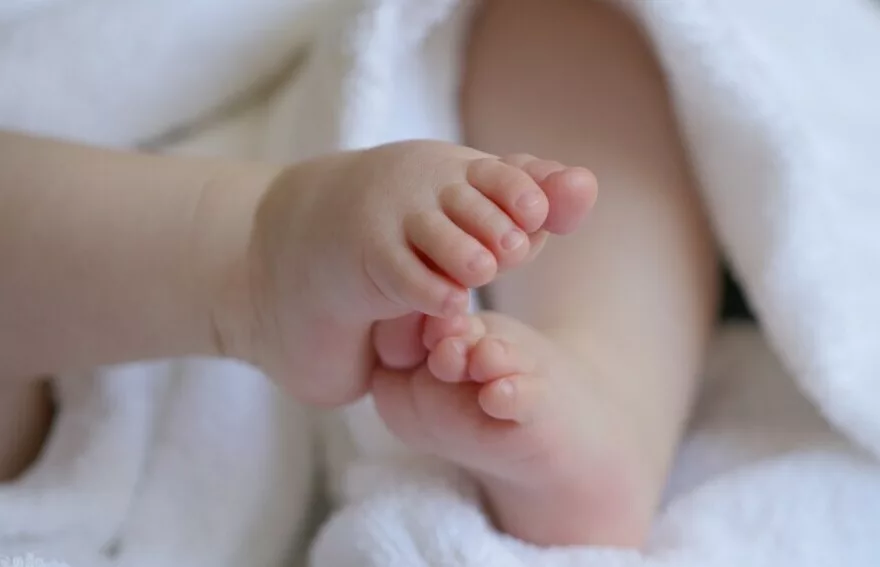Introduction
Bringing a newborn into the world is a momentous occasion, filled with wonder, joy, and a fair share of questions. Among these are the curious movements and reflexes your baby exhibits from their earliest days. These reflexes are not random or purposeless; they are vital indicators of your baby’s neurological development and overall health. Understanding these reflexes can help you better care for your newborn and provide reassurance as you navigate the early stages of parenthood.
This comprehensive guide will explore the various reflexes and movements your newborn will display, explaining their significance and when they typically occur. By understanding these natural responses, you’ll gain insight into your baby’s development and be better equipped to support their growth.

Table of Contents
Understanding Newborn Reflexes And Movements: The Importance of Reflexes in Newborns
Reflexes are involuntary, automatic responses to specific stimuli. In newborns, these reflexes are crucial for survival, as they are the body’s way of responding to the environment before the brain has fully matured to control voluntary movements. Pediatricians use these reflexes as indicators of a newborn’s neurological health and development.
Key reflexes that are present at birth include the rooting reflex, sucking reflex, Moro reflex, grasp reflex, and more. These reflexes are typically temporary and will disappear as your baby’s brain matures and they gain more control over their movements. However, their presence and strength can provide valuable information about your baby’s nervous system.
1. The Rooting Reflex
The rooting reflex is one of the first reflexes you’ll likely notice in your newborn. It helps your baby find your breast or a bottle to start feeding. When the corner of your baby’s mouth is stroked or touched, they will turn their head and open their mouth toward the side that was touched, as if searching for a nipple.
This reflex is essential for breastfeeding and typically lasts until about four months of age. It helps your baby latch onto the breast and begin sucking. If your baby is not exhibiting this reflex, it may indicate issues with feeding or neurological development, and it’s advisable to consult a pediatrician.
Key Points:
- Purpose: Aids in feeding by helping the baby locate the breast or bottle.
- Duration: Typically disappears by 4 months of age.
- Significance: Indicates healthy neurological and developmental function related to feeding.
2. The Sucking Reflex
Closely related to the rooting reflex is the sucking reflex. When the roof of your baby’s mouth is touched, they will start to suck. This reflex is crucial for feeding, whether your baby is breastfed or bottle-fed. It’s present even in utero, with ultrasounds often showing babies sucking their thumbs.
The sucking reflex is an automatic response that is vital for feeding and soothing. Babies will often suck on pacifiers, their hands, or other objects as a form of comfort. As they grow, sucking becomes less reflexive and more voluntary.
Key Points:
- Purpose: Essential for feeding and self-soothing.
- Duration: Present from birth and gradually becomes voluntary.
- Significance: Indicates readiness and ability to feed and self-comfort.
3. The Moro Reflex (Startle Reflex)
The Moro reflex, also known as the startle reflex, is one of the most dramatic newborn reflexes. It occurs when your baby is startled by a loud sound, a sudden movement, or a change in position. In response, your baby will throw their arms out, open their hands, throw their head back, and then quickly bring their arms back to their body, often with a crying or whimpering response.
This reflex is thought to be an evolutionary response that helped babies cling to their mothers in times of danger. The Moro reflex is typically present from birth and gradually disappears by six months of age. The absence of this reflex or its persistence beyond the usual timeframe can indicate neurological issues, so it’s something your pediatrician will monitor.
Key Points:
- Purpose: Primitive protective response to perceived danger.
- Duration: Present from birth and usually fades by 6 months.
- Significance: Absence or persistence may indicate neurological issues.
4. The Grasp Reflex
The grasp reflex is an endearing reflex where your baby will close their fingers around any object placed in their palm. This reflex is so strong in some newborns that they can hold onto an object or even your finger with surprising firmness. The grasp reflex also occurs in the toes, known as the plantar grasp reflex, where the baby’s toes will curl around an object touching the sole of the foot.
This reflex is believed to be another evolutionary trait, once helping infant primates cling to their mothers. The hand grasp reflex typically fades around five to six months, giving way to more voluntary hand movements. The plantar grasp reflex can last a little longer, sometimes up to a year.
Key Points:
- Purpose: An evolutionary trait for clinging to caregivers.
- Duration: Hand grasp fades by 5-6 months, and plantar grasp may last up to 1 year.
- Significance: Reflects normal development of motor skills.
5. The Stepping Reflex
The stepping reflex is fascinating to observe. When you hold your newborn upright with their feet touching a flat surface, they will make stepping motions as if they are trying to walk. This reflex is usually present at birth and disappears by two months of age. It’s often referred to as a “walking” or “dancing” reflex.
This reflex is a precursor to walking and indicates healthy muscle tone and neural function in your baby’s legs. While it disappears early, it’s not a cause for concern. It simply means that your baby’s movements are becoming more refined and controlled as their brain matures.
Key Points:
- Purpose: Precursor to voluntary walking.
- Duration: Present from birth and disappears by 2 months.
- Significance: Indicates healthy muscle tone and neural development.
6. The Tonic Neck Reflex
The tonic neck reflex, also known as the “fencing position,” occurs when your baby’s head is turned to one side. In response, the arm on that side will stretch out, while the opposite arm bends at the elbow, resembling a fencing position. This reflex is thought to help develop hand-eye coordination.
The tonic neck reflex is typically present from birth and fades by five to seven months of age. Its persistence beyond this period may be a sign of developmental delays and should be discussed with your pediatrician.
Key Points:
- Purpose: May aid in the development of hand-eye coordination.
- Duration: Present from birth and fades by 5-7 months.
- Significance: Persistence may indicate developmental delays.
7. The Babinski Reflex
The Babinski reflex is observed when the sole of your baby’s foot is gently stroked. In response, the big toe bends back toward the top of the foot, and the other toes fan out. This reflex is present in newborns but usually disappears by two years of age.
The Babinski reflex is part of the neurological examination in infants and can indicate healthy development. However, if the reflex persists beyond two years, it may be a sign of a neurological disorder and should be evaluated by a healthcare professional.
Key Points:
- Purpose: Indicator of neurological development.
- Duration: Present from birth and fades by 2 years.
- Significance: Persistence beyond 2 years may indicate neurological issues.
8. The Galant Reflex
The Galant reflex occurs when the skin along your baby’s spine is stroked while they are lying on their stomach. In response, your baby will curve their body toward the side that was stroked. This reflex is believed to help the baby’s body move through the birth canal during delivery.
The Galant reflex typically disappears by four to six months of age. Its presence is often checked during routine pediatric exams to assess the integrity of the spinal cord and nervous system.
Key Points:
- Purpose: May assist in birth canal movement.
- Duration: Present from birth and fades by 4-6 months.
- Significance: Reflects spinal cord and nervous system integrity.
The Evolution of Reflexes into Voluntary Movements
As your baby grows, you’ll notice that these reflexes gradually fade and are replaced by more controlled, voluntary movements. This transition is a normal part of development, as the brain matures and gains control over motor functions.
For instance, the grasp reflex will give way to voluntary grasping, where your baby will reach for and hold objects intentionally. The stepping reflex will evolve into actual walking as your baby’s muscles and coordination improve. These milestones are exciting to witness and indicate that your baby is developing appropriately.
Monitoring and Supporting Your Baby’s Development
While reflexes are a natural part of newborn development, it’s important to monitor their progression. Your pediatrician will check these reflexes during routine visits to ensure they are present and diminishing as expected. If a reflex is absent or persists beyond the normal timeframe, it may warrant further investigation to rule out any underlying neurological issues.
As a parent, you can support your baby’s development by providing a safe and stimulating environment. Tummy time, for example, is crucial for building strength in the neck, shoulders, and back, which are essential for achieving developmental milestones like rolling over, sitting up, and crawling. Encouraging your baby to explore their surroundings, reach for objects, and practice different movements will help them gain the skills they need as they grow.
When to Seek Medical Advice
While many reflexes are normal and expected, there are times when you should seek medical advice. If you notice that a reflex is absent, particularly the Moro or sucking reflexes, or if a reflex persists beyond the expected age, it’s important to consult your pediatrician. Additionally, if your baby’s movements seem unusually stiff, floppy, or asymmetrical, it may be worth discussing with a healthcare professional.
Persistent abnormal reflexes could indicate conditions such as cerebral palsy, developmental delays, or other neurological concerns. Early intervention is key in these cases, so don’t hesitate to seek advice if you have any concerns.
Conclusion
Understanding your newborn’s reflexes and movements is not only fascinating but also essential for monitoring their development. These reflexes are critical indicators of your baby’s neurological health and are carefully monitored by healthcare providers to ensure your baby is on the right developmental track.
As you observe your baby’s reflexes and movements, remember that each child is unique and may develop at their own pace. However, knowing what to expect and when to seek help will empower you to support your baby’s growth effectively.
In these early months, your baby’s reflexes are just the beginning of a lifetime of learning and development. By fostering a nurturing and responsive environment, you’re setting the stage for your child’s future success and well-being.
Be sure to check out other great, informative, fantastic, innovative, invigorating…. okay, you get the point… we have so many other must reads, such as, Creative Baby Bonding Activities | (new-parents.com) or Breastfeeding Diet For New Mothers | (new-parents.com) or Top 5 Breast Pumps For Working Moms | (new-parents.com)… I think you get the idea. We sincerely thank you for stopping by.
References
- Gonzalez, C. E., & Fisher, M. S. (2021). Newborn Reflexes and Neurological Development. Journal of Pediatric Medicine, 34(2), 215-222.
- Smith, A. J. (2019). The Role of Reflexes in Early Childhood Development. Pediatric Healthcare Review, 28(4), 334-341.
- American Academy of Pediatrics. (2022). Developmental Milestones: Understanding Your Baby’s Reflexes. Retrieved from https://www.aap.org.
- World Health Organization. (2021). Neurological Health in Infants: A Comprehensive Guide. Retrieved from https://www.who.int.
